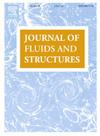DeepVIVONet: Using deep neural operators to optimize the location of sensors with application to vortex-induced vibrations
IF 3.4
2区 工程技术
Q1 ENGINEERING, MECHANICAL
引用次数: 0
Abstract
We introduce DeepVIVONet, a new framework for optimal dynamic reconstruction and forecasting using field data of the vortex-induced vibrations (VIV) of a marine riser. We demonstrate the effectiveness of DeepVIVONet in accurately reconstructing the motion of an off–shore marine riser by using sparse spatio-temporal measurements. We also show the generalization of our model in extrapolating to other flow conditions via transfer learning, underscoring its potential to streamline operational efficiency and enhance predictive accuracy. The trained DeepVIVONet serves as a fast and accurate surrogate model for the marine riser, which we use in an outer-loop optimization algorithm to obtain the optimal locations for placing the sensors. Furthermore, we employ an existing sensor placement method based on proper orthogonal decomposition (POD) to compare with our data-driven approach. We find that that while POD offers a good approach for initial sensor placement, DeepVIVONet’s adaptive capabilities yield more precise and cost-effective configurations.
DeepVIVONet:使用深度神经算子优化传感器的位置,应用于涡激振动
本文介绍了DeepVIVONet,这是一个利用海洋隔水管涡激振动(VIV)现场数据进行最优动态重建和预测的新框架。我们证明了DeepVIVONet通过使用稀疏时空测量准确重建海上立管运动的有效性。我们还展示了我们的模型在通过迁移学习外推到其他流动条件时的泛化,强调了其简化操作效率和提高预测准确性的潜力。经过训练的DeepVIVONet可以作为海洋立管的快速、准确的替代模型,我们将其用于外环优化算法,以获得放置传感器的最佳位置。此外,我们采用现有的基于适当正交分解(POD)的传感器放置方法与我们的数据驱动方法进行比较。我们发现,虽然POD为初始传感器放置提供了一种很好的方法,但DeepVIVONet的自适应能力可以产生更精确、更经济的配置。
本文章由计算机程序翻译,如有差异,请以英文原文为准。
求助全文
约1分钟内获得全文
求助全文
来源期刊

Journal of Fluids and Structures
工程技术-工程:机械
CiteScore
6.90
自引率
8.30%
发文量
173
审稿时长
65 days
期刊介绍:
The Journal of Fluids and Structures serves as a focal point and a forum for the exchange of ideas, for the many kinds of specialists and practitioners concerned with fluid–structure interactions and the dynamics of systems related thereto, in any field. One of its aims is to foster the cross–fertilization of ideas, methods and techniques in the various disciplines involved.
The journal publishes papers that present original and significant contributions on all aspects of the mechanical interactions between fluids and solids, regardless of scale.
 求助内容:
求助内容: 应助结果提醒方式:
应助结果提醒方式:


